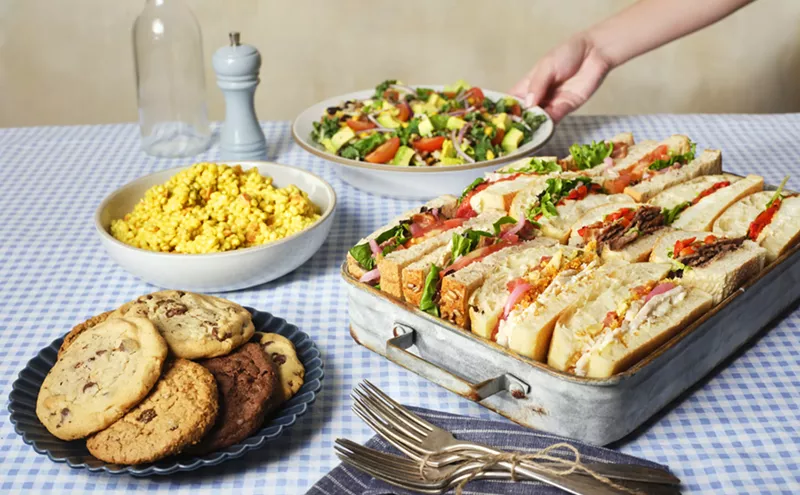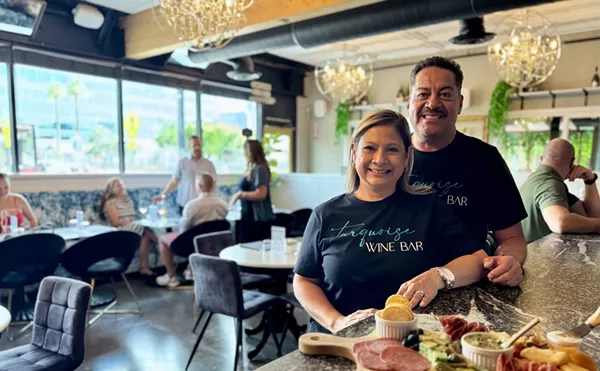It's not necessarily the adulation. Restaurant diners think nothing of picking apart a meal, complaining from Caesar salad (not enough croutons) to crème brûlée (too much crust). If they tried this at home, Mom would whop them upside the head, but professional chefs are open targets for insults.
It's not the money. Most chefs earn $30,000, the top guys about $48,000, I was amazed to find out. On top of it, these days, a chef has a hard time even being considered for a job without a formal education. Hence the boom in cooking schools, where the cost of learning is high. Like at the Valley's newest Arizona Culinary Institute (ACI), where tuition for a nine-month program in classic French cuisine rings in at a jaw-dropping $16,210. Still, classes already are operating at near capacity in the school, which opened this spring.
And there's more in store for these students. Included in the curriculum is the "benefit" of working for free for six weeks in ACI's on-site, open-to-the-public restaurant, du Jour. The idea is that pupils can get hands-on experience in what's it's like to be on the front lines; I'm thinking it's a cool coincidence that students provide free labor in a for-profit cafe.
It's a head-scratcher, the burning desire to be a chef. The school operators certainly come out great. (Cha-ching! There's good reason that food industry people like to gossip that this is former governor Fife Symington's school, though he's nowhere to be found on the official management and ownership rosters, and has nothing to do with daily operations except that his wife provides funding.) The dining public wins: We get to enjoy these student "training" meals for incredible bargains -- generally $9 to $13 for a satisfying three-course meal including appetizer, entree, dessert, and tea or coffee. But as my du Jour server explains to me how happy he is that it's finally fall -- since the kitchen got up to 115 degrees in the summer, fueled by hot stoves and open flame -- I must admit that professional cooking isn't in my blood.
I'd be a lousy student, not like the bright-eyed, white-clad gentleman who greets me at du Jour's door, proudly showing me experimental displays of intricate spun-sugar art while I wait for my friend to arrive. It's a patience thing: If a dish cooks in two hours at 250 degrees, I don't see why it won't cook just as well in one hour at 500. And this lad is telling me that just learning how to handle the hot sweetener without singeing fingers takes at least a week.
These people understand restraint; there's just an elegant, slender drizzle of crème fraîche in the soups (the menu changes daily) -- a rich, highly smoky tomato bisque with onions, celery and garlic; and a gorgeous, velvety cream of asparagus decorated with asparagus sprigs and chives. I adore crème fraîche and, left to my own devices, would likely drown the soups in it and ruin them.
Real cooking requires more discipline than I can muster. Just eating at du Jour requires careful planning. The cafe is open only for weekday lunch, and then only between 11:30 a.m. and 12:45 p.m. Reservations are required for the busy, noisy bistro, taken in 15-minute increments. Folks showing up late are shown the door, and complete parties are required for seating. We've got to order quickly: Popular dishes sell out fast, from a choice of four appetizers and five entrees, including meat, chicken, pasta, fish and vegetarian selections. Staffers work under the microscope, too: A giant window showcases an exposition kitchen done in gleaming stainless steel and manned by eager types clad in pristine chefs' whites.
Most of the time, the kitchen rises to the task, timing our multiple courses perfectly and producing food that, while often simply serviceable, is fresh and filling. No, it's not often remarkable, but it's all quite nice, and the place is always feel-good busy.
All is classic with French onion soup, served sherry-kissed and blistery in a crock under bubbling Gruyère, and baby field greens arrive in an impressive mound tossed with candied pistachios, Gorgonzola, orange segments and a nicely sugary Calvados citrus vinaigrette.
These cooks are better with butter than I am, too, napping a silky puddle of lemon-dill beurre blanc under a moist fillet of grilled Atlantic salmon atop fine orzo rice pilaf. Roasted corn coulis is delightful as well, vegetable-sweet and a cheery complement to two cornmeal-crusted ocean perch fillets, baked and plopped over mashed sweet potatoes (too much sweet on one plate for my tastes, but prepared correctly nonetheless). And there's nothing to complain about as far as meat quality, be it filet mignon marchands de vin (a heavily reduced sauce of red wine, black pepper, butter and lemon) or slow-roasted pork loin finished with pepper sauce over pesto mashed potatoes.
I feel tacky being picky about du Jour's stumblings. Even with its fancy white tablecloths, linen napkins and big-time touches like offering amuses (free nibbles to start the meal), wine pairings, butter shaped like roses and full place settings (three forks, two goblets, etc.), it's still a classroom. It's easy to forgive creative but confusing dishes like a seared pancetta-wrapped sea scallop with a chiffonade of smoked cabbage, Asian slaw and tonkatsu sauce. The scallop is perfect and the pancetta crisp like lusty bacon, but the sauce is odd, tomatoey and spicy, and the whole plate is just too busy. Yet hey, ACI's catalogue does tell us that du Jour is a working laboratory.
It's more difficult to understand why, on several visits, the bread is stale and the vegetables of the day are tooth-cracking hard. I also expect more from a chicken ballotine, a puny boneless chicken leg served with greasy skin on. It's stuffed with a wonderful mushroom duxelle (finely chopped with herbs and butter) and rests on a lovely sauce supreme (rich, creamy, stock-based white sauce), but the bird itself is too lowbrow a bite. And I would never send out an amuse of a tiny chicken drumstick coated in toasted (burned) sesame seeds and splashing about in an annoyingly salty-pungent brew of ginger soy.
I haven't cooked a dessert since two years ago, when I tried to cheat with a prepackaged crust and found I couldn't cut through the finished apple pie. Who knew I was supposed to remove the paper liner from the dough?
So it's terrific that the puzzling perfectionists at ACI tussle with sleepless nights to create tasty plates like peanut-butter cookies with seriously liquored bananas Foster ice cream, and moist pumpkin pie with ice cream so drenched with Irish spirits it risks spontaneous combustion. Carrot cake is a whopping piece and not too sugary; an assorted pastry plate is over-the-top gluttony, with Bavarian cremes, chocolate nut balls, white-chocolate sheets, coulis and fresh berries.
Actually, there is an explanation for what drives some people to be kitchen slaves. Scientists in Geneva call it "Gourmand Syndrome," in which some people develop an intense, consuming passion for food, including addiction-like cravings for superior taste, an inordinate interest in a dish's appearance, a savoring of trips to shop for ingredients, and delight in the memory of particular restaurant experiences. It can happen after sustaining an injury to the right side of the brain, such as a tumor, concussion, stroke or severe impact with a blunt instrument.
I'm not buying it, though. I was dropped on my head plenty as a baby, and I still don't want to cook.











